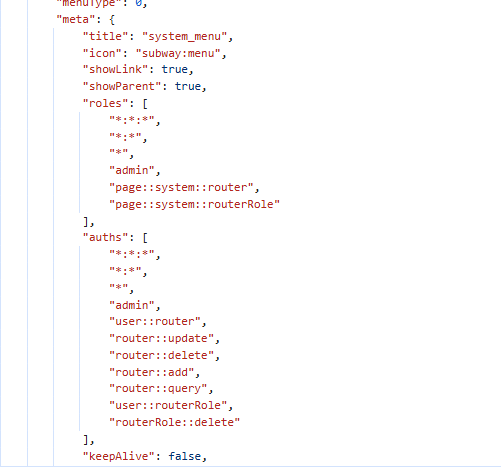10 KiB
BunnyAuth Dynamic Permission Control Introduction
[!IMPORTANT]
Open-source permission template: Pure-admin
Pure-admin Documentation: https://pure-admin.github.io/pure-admin-doc
Default Credentials
The project includes a default administrator with user
id1in the database:Username:
AdministratorPassword:
admin123
[!WARNING]
If the password for the administrator [
Administrator] is incorrect during initial login:Locate the
sys_usertable in the database and replace the password forAdministratorwith the following:
$2a$10$h5BUwmMaVcEuu7Bz0TPPy.PQV8JP6CFJlbHTgT78G1s0YPIu2kfXe
Flexible permission control with multi-platform file upload support.
📽️ Video Tutorials
Introduction Videos
- RBAC URL Permission Database and Backend Design
- Bunny-Admin Configuration Guide
- Bunny-Admin User Operations
- Bunny-Admin Role Permissions
- Bunny-Admin Remaining Business Logic
- Code Generator
GitHub Repositories
- Permission Backend: https://github.com/BunnyMaster/bunny-admin-server
- Permission Frontend: https://github.com/BunnyMaster/bunny-admin-web
- Code Generator: https://github.com/BunnyMaster/generator-code-server
Gitee Repositories
- Permission Backend: https://gitee.com/BunnyBoss/bunny-admin-server
- Permission Frontend: https://gitee.com/BunnyBoss/bunny-admin-web
- Code Generator: https://gitee.com/BunnyBoss/generator-code-server
🚀 Project Overview
A modern dynamic permission control system based on Spring Security 6, providing a complete RBAC permission management solution. Supports frontend-backend separation architecture and flexible fine-grained permission control.
😋 Controller Annotation Guide
The project is URL-based for easy permission interface definition. Permissions can be added or deleted via URLs, even if the interface does not exist in the project.
For example, if a role needs access to all interfaces under dept, the URL can be written as api/dept/**. For specific interfaces like /api/dept/aaa/bbb, the URL can be customized accordingly.
For paginated queries with URL parameters, use /api/dept/*/* for flexible permission control.
In scenarios where interfaces directly represent permissions, manually adding each URL is tedious. Instead, Swagger annotations and the custom PermissionTag annotation can be used. Reflection-based permission addition is also supported. Refer to the ReadMe in the controller directory for details.
✨ Major Updates
Core Improvements
v4.0.0
- Complete Refactoring: Backend interfaces, entity classes, and frontend optimizations.
- Batch Operations Support:
- ✅ Menu Management: Enhanced attribute content.
- ✅ Permission Management: JSON/Excel import/export.
- ✅ Role Management: Excel batch updates.
- ✅ Multi-language Configuration: JSON/Excel updates (full replacement mode).
v4.0.1
- File system supports multiple platforms with manual configuration.
- Reference documentation: https://x-file-storage.xuyanwu.cn/#/
- File deletion and download require implementing the
FileRecorderinterface. The code and controllers are in thefiledirectory. Modify as needed based on the [x-file-storage] documentation.
🧠 Usage Tips
[!TIP]
Multi-language Usage Tips:
While direct JSON file manipulation may be challenging for some users, JSON offers unique advantages in multi-language projects:
- Structured format for easy AI parsing.
- Efficient translation workflow:
- Developers only need to complete the Chinese version.
- Upload JSON to AI translation tools.
- Simple commands generate English/Traditional Chinese/Korean versions.
- Saves significant development time with a "write once, adapt for multiple languages" approach.
🔐 Permission Control System
Access Rules Configuration
Configured via WebSecurityConfig:
| Path Type | Example | Access Requirement | Configuration Method |
|---|---|---|---|
| Public Interface | /api/public/** |
No authentication | Path contains public keyword |
| Private Interface | /api/private/** |
Requires login | Path contains private keyword |
Path Matching Strategy
public static String[] annotations = { ... };
// Configuration Example
http.authorizeHttpRequests(auth -> auth
.authorizeHttpRequests(authorize -> authorize
.requestMatchers(annotations).permitAll()
);
Maven Project Structure
bunny-auth/
├── auth-api # Interface Layer
├── auth-core # Core Module
│ ├── config # Security Configuration
│ └── domain # Domain
│ └── ...... # And more...
├── service # Business Implementation
└── dao # Data Persistence Layer
🛠️ Use Cases
1. Frontend-Only Control Mode
Frontend details: https://pure-admin.cn/pages/RBAC/#%E5%A6%82%E4%BD%95%E9%85%8D%E7%BD%AE
- Page Control:
- Assign roles to route menus.
- Assign roles to users.
- Button Control:
// Frontend Permission Codes const auth = { add: ['i18nType::add'], update: ['i18nType::update'], delete: ['i18nType::delete'], };
2. Backend-Only Control Mode
-
Interface-level permissions: For pagination, use
/api/permission/*/*.@Tag(name = "System Permissions") @PermissionTag(permission = "permission::*") @RestController @RequestMapping("api/permission") public class PermissionController { @Operation(summary = "Pagination Query") @PermissionTag(permission = "permission::query") @GetMapping("{page}/{limit}") public Result<PageResult<PermissionVo>> getPermissionPage( @PathVariable Integer page, @PathVariable Integer limit) { // ... } }
3. Full-Stack Control Mode
Combine the above two approaches.
🛡️ Security Configuration
Path Matching Strategy
AntPath details: https://juejin.cn/spost/7498247273660743732
| Pattern | Example | Description |
|---|---|---|
| Exact Match | /api/user |
Matches exact path |
| Single Wildcard | /api/user/* |
Matches single level |
| Multi Wildcard | /api/user/** |
Matches multiple levels |
| Method Specific | GET /api/user |
Matches HTTP method |
🧰 Technology Stack
😄 Frontend
- Vue 3 + PureAdmin Template
- Custom Permission Components
- Internationalization Support
😃 Backend
- Spring Boot 3 + Spring Security 6
- JDK 17
- MySQL + Redis + MinIO
- Swagger + Knife4j Documentation
😀 Development Environment
Docker startup varies by version:
# Start dependency services with one command
docker-compose up -d
# For newer Docker versions
docker compose up -d
📚 Best Practices
- Annotation Standards:
@Tag(name = "Module Name", description = "Module Description") @Operation(summary = "Interface Summary", tags = {"Permission Code"}) // Or @Operation(summary = "Interface Summary", tags = "Permission Code") - Permission Code Design:
- Module::Operation (e.g.,
user::create). - Hierarchical design (e.g.,
system:user:update).
- Module::Operation (e.g.,
- Batch Operations:
- Manage permissions via Excel/JSON.
- Regularly backup permission configurations.
🌟 Project Advantages
- True Dynamic Control – No hardcoded permission logic.
- Flexible Data Import – Supports multiple file formats.
- Fine-Grained Control – Multi-level permissions from pages to buttons.
- Modern Tech Stack – Based on the latest Spring ecosystem.
- Out-of-the-Box – Complete Docker deployment solution.
📌 Notes
- Multi-language updates fully replace existing configurations.
- Disable Swagger endpoints in production.
- Use Excel for complex permission management.
📈 Future Plans
None at the moment.
📏 Frontend-Backend Interface Standards
🌐 Frontend Example Standards
| Action | API Layer | Pinia Layer |
|---|---|---|
| Query Single | getUser |
loadUser |
| Query List | getUserList |
loadUserList |
| Pagination | getUserPage |
fetchUserPage |
| Add Data | createUser |
addUser |
| Update Data | updateUser |
editUser |
| Delete Data | deleteUser |
removeUser |
🛟 Backend Interface Example Standards
Follows RESTful standards.
| Action | RESTful |
|---|---|
| Query List | GET /users |
| Pagination | GET /users/{page}/{limit} |
| Query Single | GET /users/{id} |
| Add | POST /users |
| Update | PUT /users/{id} |
| Delete | DELETE /users/{id} |








